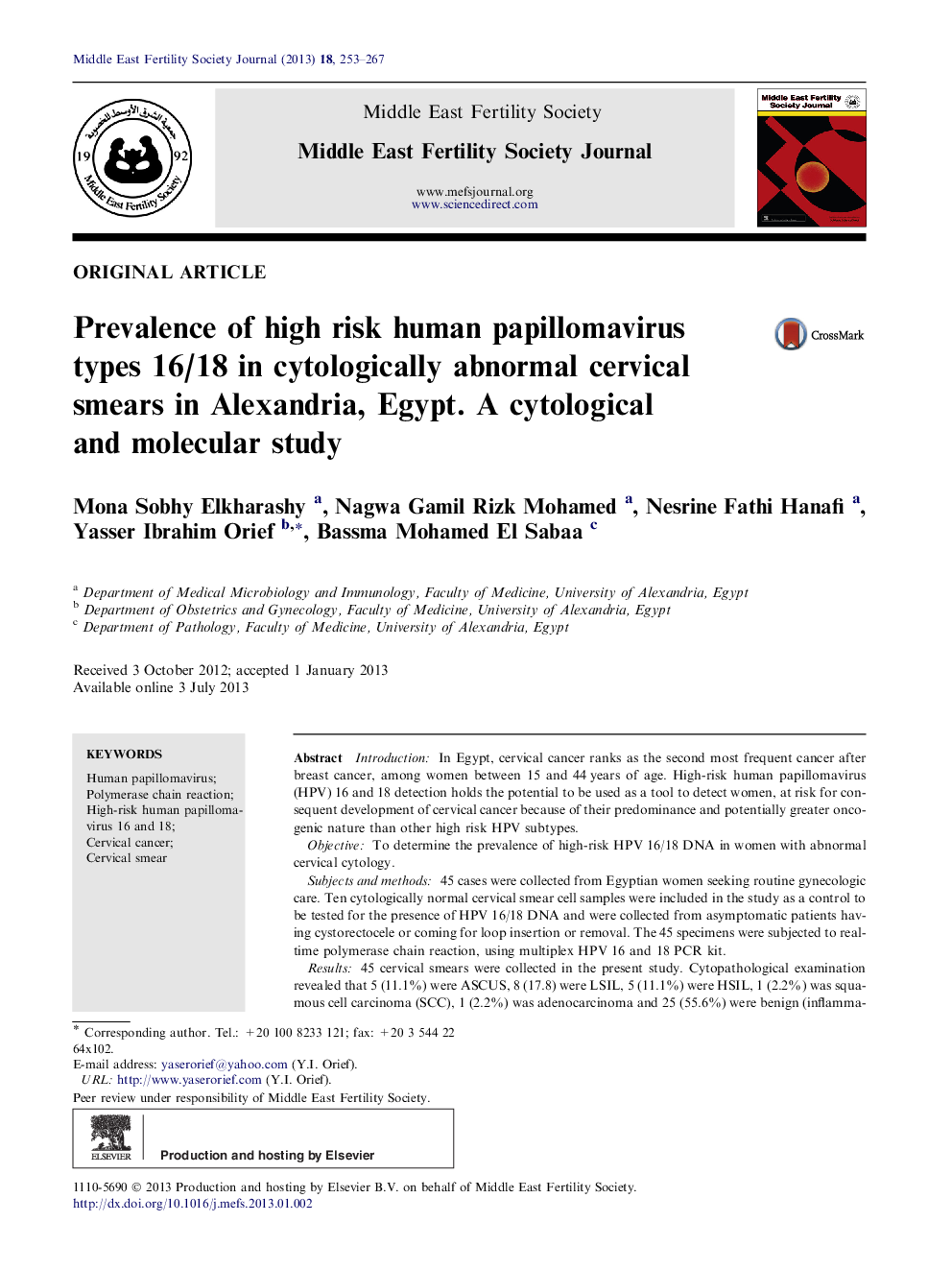| Article ID | Journal | Published Year | Pages | File Type |
|---|---|---|---|---|
| 3966254 | Middle East Fertility Society Journal | 2013 | 15 Pages |
IntroductionIn Egypt, cervical cancer ranks as the second most frequent cancer after breast cancer, among women between 15 and 44 years of age. High-risk human papillomavirus (HPV) 16 and 18 detection holds the potential to be used as a tool to detect women, at risk for consequent development of cervical cancer because of their predominance and potentially greater oncogenic nature than other high risk HPV subtypes.ObjectiveTo determine the prevalence of high-risk HPV 16/18 DNA in women with abnormal cervical cytology.Subjects and methods45 cases were collected from Egyptian women seeking routine gynecologic care. Ten cytologically normal cervical smear cell samples were included in the study as a control to be tested for the presence of HPV 16/18 DNA and were collected from asymptomatic patients having cystorectocele or coming for loop insertion or removal. The 45 specimens were subjected to real-time polymerase chain reaction, using multiplex HPV 16 and 18 PCR kit.Results45 cervical smears were collected in the present study. Cytopathological examination revealed that 5 (11.1%) were ASCUS, 8 (17.8) were LSIL, 5 (11.1%) were HSIL, 1 (2.2%) was squamous cell carcinoma (SCC), 1 (2.2%) was adenocarcinoma and 25 (55.6%) were benign (inflammatory). 20 patients with abnormal cervical cytology and 10 controls were included in the present study. In patients with abnormal cervical cytology, 5 (25%) were ASCUS, 8 (40%) were LSIL, 5 (25%) were HSIL, and 1 (5%) was SCC and 1 (5%) was adenocarcinoma. Statistical analysis revealed a significant difference between patient and control groups as regards regularity of menstruation where irregular menstruation and higher prevalence of menopausal women, abnormal vaginal bleeding, menorrhagia, vaginal infection, and abnormal cervical appearance were encountered in patients. A statistically significant higher prevalence of married women was found in the control group. There was no significant difference in the distribution of patients and control as regards HPV 16 or HPV 18 in which 20% of patients were HPV 16 positive and 10% of patients were HPV 18 positive compared with none in the control group. 6 were positive either for HPV 16 or 18, while 39 were negative. The HPV 16/18 positive patients had significantly higher age and marital duration when compared with HPV 16/18 negative group. Significantly, most of the HPV 16/18 positive patients were menopause. A significantly higher prevalence of women with cervicitis, contraceptive users and married women was in the HPV 16/18 negative group.ConclusionThe study generates epidemiological data of prevalence of HPV 16/18 in cytologically abnormal cervical smears in women seeking routine gynecologic care at the outpatient clinics of the Obstetrics and Gynecology Department at El Shatby University. High-risk HPV DNA testing by PCR of cervical samples diagnosed according to the Bethesda 2001 guidelines may benefit the management of patients with abnormal cervical smears, especially among women aged 46 years and older, in menopausal women and in women complaining of PMB. Therefore, HPV DNA testing should be made use of as an adjunct to cervical smears.
